Analysis of the English Legal System and Court Structures
VerifiedAdded on 2020/12/30
|11
|3433
|250
Report
AI Summary
This report provides an overview of the English legal system, detailing the different types of law including civil, criminal, common, and statutory law. It explores the main principles of criminal law, such as Actus Reus, Mens Rea, and the burden of proof. The report analyzes the structure of the Magistrates and Crown Courts, outlining the types of cases each court handles, including summary offenses, either-way offenses, and indictable-only offenses. It also examines the route for appeals within the criminal court structure and the importance of the court hierarchy. The report aims to provide a comprehensive understanding of the legal system's framework and its practical application in criminal proceedings.
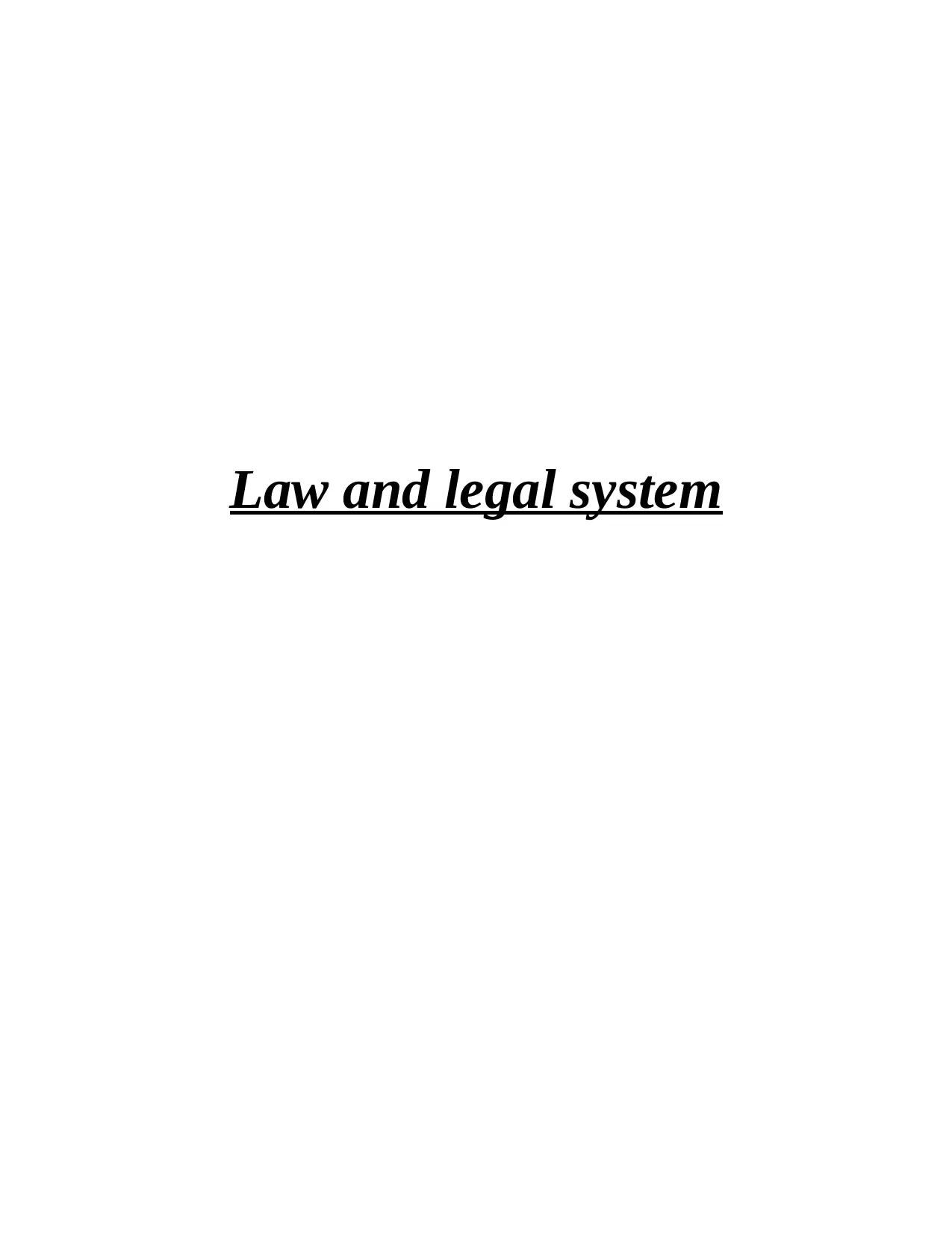
Law and legal system
Paraphrase This Document
Need a fresh take? Get an instant paraphrase of this document with our AI Paraphraser
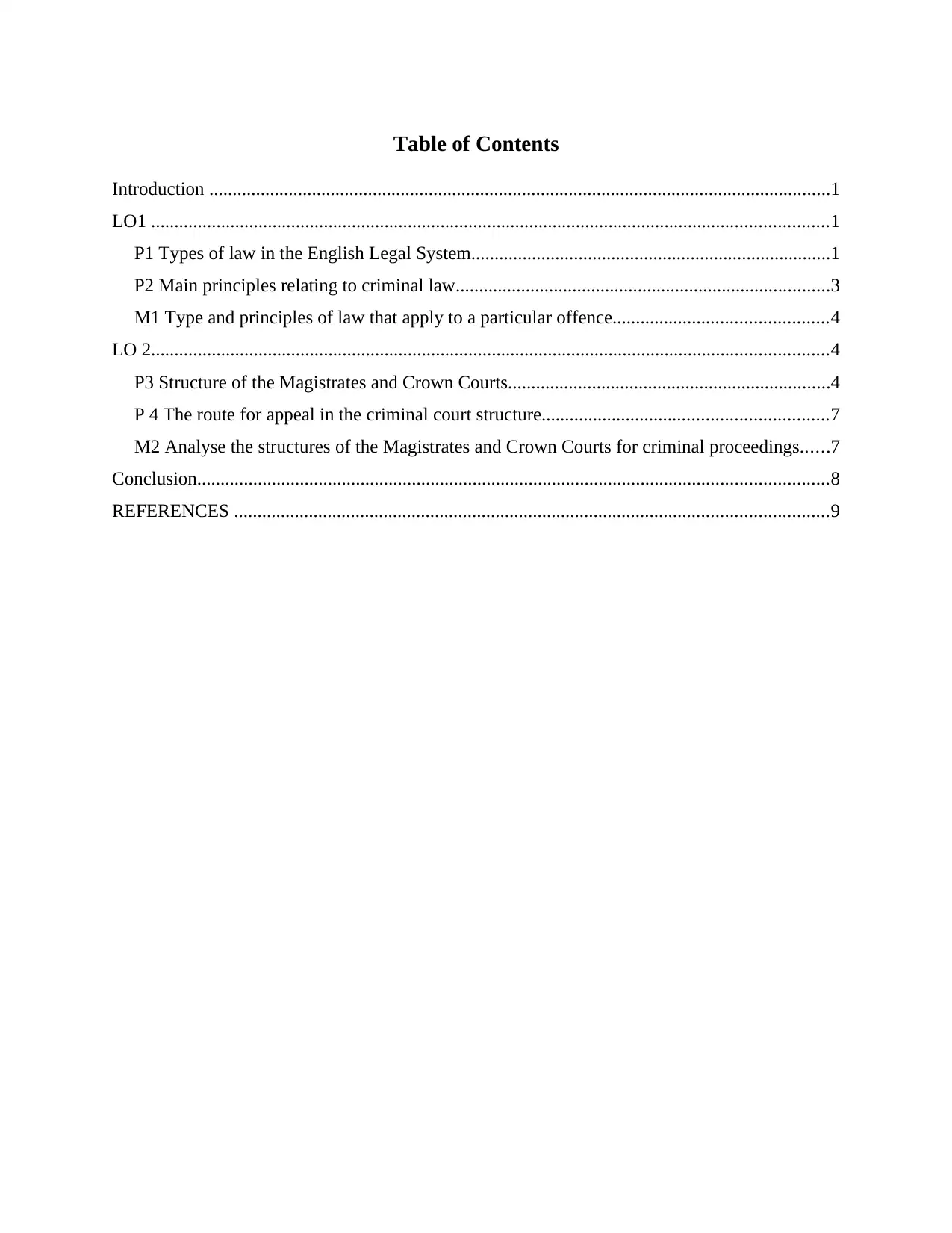
Table of Contents
Introduction .....................................................................................................................................1
LO1 .................................................................................................................................................1
P1 Types of law in the English Legal System.............................................................................1
P2 Main principles relating to criminal law................................................................................3
M1 Type and principles of law that apply to a particular offence..............................................4
LO 2.................................................................................................................................................4
P3 Structure of the Magistrates and Crown Courts.....................................................................4
P 4 The route for appeal in the criminal court structure.............................................................7
M2 Analyse the structures of the Magistrates and Crown Courts for criminal proceedings......7
Conclusion.......................................................................................................................................8
REFERENCES ...............................................................................................................................9
Introduction .....................................................................................................................................1
LO1 .................................................................................................................................................1
P1 Types of law in the English Legal System.............................................................................1
P2 Main principles relating to criminal law................................................................................3
M1 Type and principles of law that apply to a particular offence..............................................4
LO 2.................................................................................................................................................4
P3 Structure of the Magistrates and Crown Courts.....................................................................4
P 4 The route for appeal in the criminal court structure.............................................................7
M2 Analyse the structures of the Magistrates and Crown Courts for criminal proceedings......7
Conclusion.......................................................................................................................................8
REFERENCES ...............................................................................................................................9
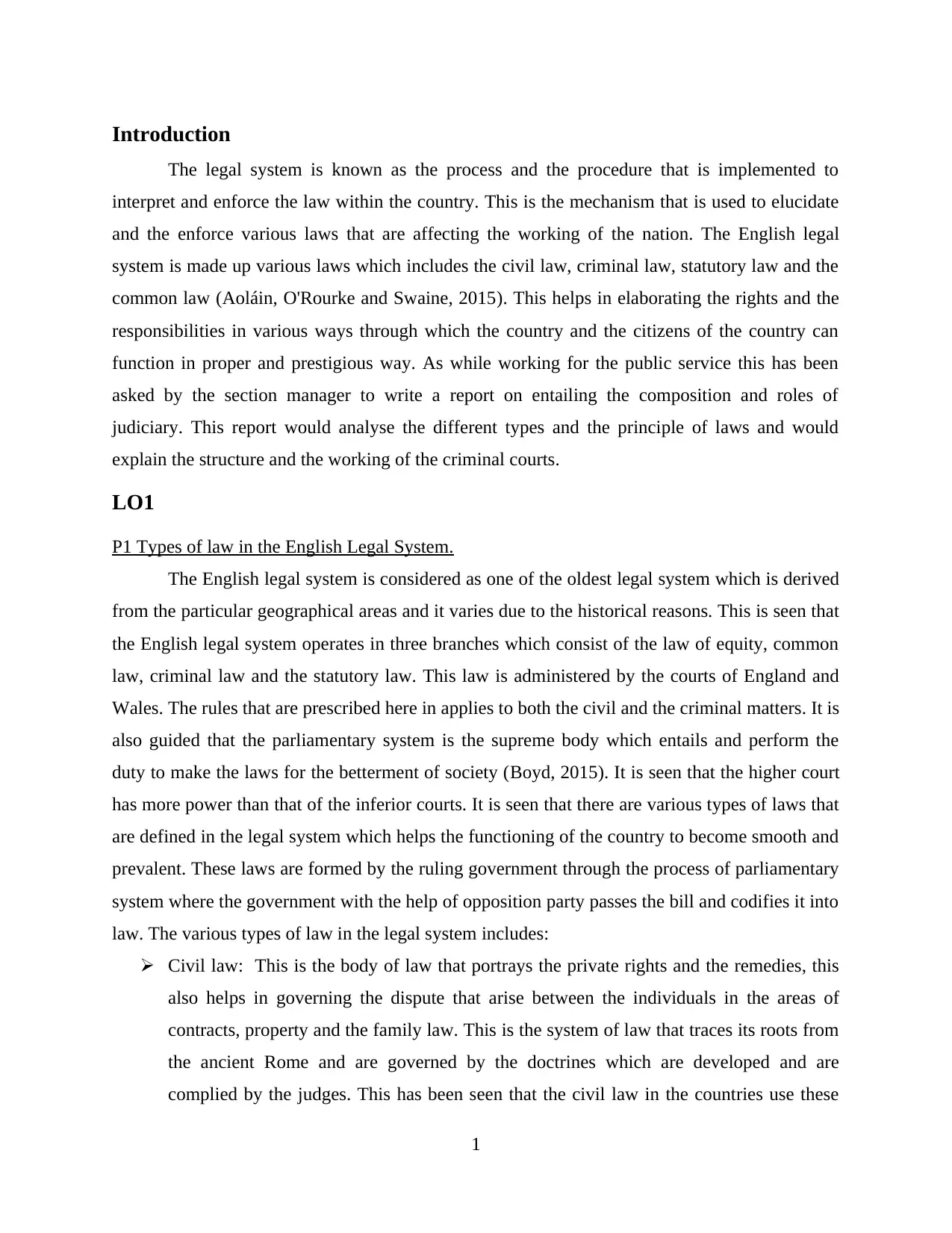
Introduction
The legal system is known as the process and the procedure that is implemented to
interpret and enforce the law within the country. This is the mechanism that is used to elucidate
and the enforce various laws that are affecting the working of the nation. The English legal
system is made up various laws which includes the civil law, criminal law, statutory law and the
common law (Aoláin, O'Rourke and Swaine, 2015). This helps in elaborating the rights and the
responsibilities in various ways through which the country and the citizens of the country can
function in proper and prestigious way. As while working for the public service this has been
asked by the section manager to write a report on entailing the composition and roles of
judiciary. This report would analyse the different types and the principle of laws and would
explain the structure and the working of the criminal courts.
LO1
P1 Types of law in the English Legal System.
The English legal system is considered as one of the oldest legal system which is derived
from the particular geographical areas and it varies due to the historical reasons. This is seen that
the English legal system operates in three branches which consist of the law of equity, common
law, criminal law and the statutory law. This law is administered by the courts of England and
Wales. The rules that are prescribed here in applies to both the civil and the criminal matters. It is
also guided that the parliamentary system is the supreme body which entails and perform the
duty to make the laws for the betterment of society (Boyd, 2015). It is seen that the higher court
has more power than that of the inferior courts. It is seen that there are various types of laws that
are defined in the legal system which helps the functioning of the country to become smooth and
prevalent. These laws are formed by the ruling government through the process of parliamentary
system where the government with the help of opposition party passes the bill and codifies it into
law. The various types of law in the legal system includes:
Civil law: This is the body of law that portrays the private rights and the remedies, this
also helps in governing the dispute that arise between the individuals in the areas of
contracts, property and the family law. This is the system of law that traces its roots from
the ancient Rome and are governed by the doctrines which are developed and are
complied by the judges. This has been seen that the civil law in the countries use these
1
The legal system is known as the process and the procedure that is implemented to
interpret and enforce the law within the country. This is the mechanism that is used to elucidate
and the enforce various laws that are affecting the working of the nation. The English legal
system is made up various laws which includes the civil law, criminal law, statutory law and the
common law (Aoláin, O'Rourke and Swaine, 2015). This helps in elaborating the rights and the
responsibilities in various ways through which the country and the citizens of the country can
function in proper and prestigious way. As while working for the public service this has been
asked by the section manager to write a report on entailing the composition and roles of
judiciary. This report would analyse the different types and the principle of laws and would
explain the structure and the working of the criminal courts.
LO1
P1 Types of law in the English Legal System.
The English legal system is considered as one of the oldest legal system which is derived
from the particular geographical areas and it varies due to the historical reasons. This is seen that
the English legal system operates in three branches which consist of the law of equity, common
law, criminal law and the statutory law. This law is administered by the courts of England and
Wales. The rules that are prescribed here in applies to both the civil and the criminal matters. It is
also guided that the parliamentary system is the supreme body which entails and perform the
duty to make the laws for the betterment of society (Boyd, 2015). It is seen that the higher court
has more power than that of the inferior courts. It is seen that there are various types of laws that
are defined in the legal system which helps the functioning of the country to become smooth and
prevalent. These laws are formed by the ruling government through the process of parliamentary
system where the government with the help of opposition party passes the bill and codifies it into
law. The various types of law in the legal system includes:
Civil law: This is the body of law that portrays the private rights and the remedies, this
also helps in governing the dispute that arise between the individuals in the areas of
contracts, property and the family law. This is the system of law that traces its roots from
the ancient Rome and are governed by the doctrines which are developed and are
complied by the judges. This has been seen that the civil law in the countries use these
1
⊘ This is a preview!⊘
Do you want full access?
Subscribe today to unlock all pages.

Trusted by 1+ million students worldwide
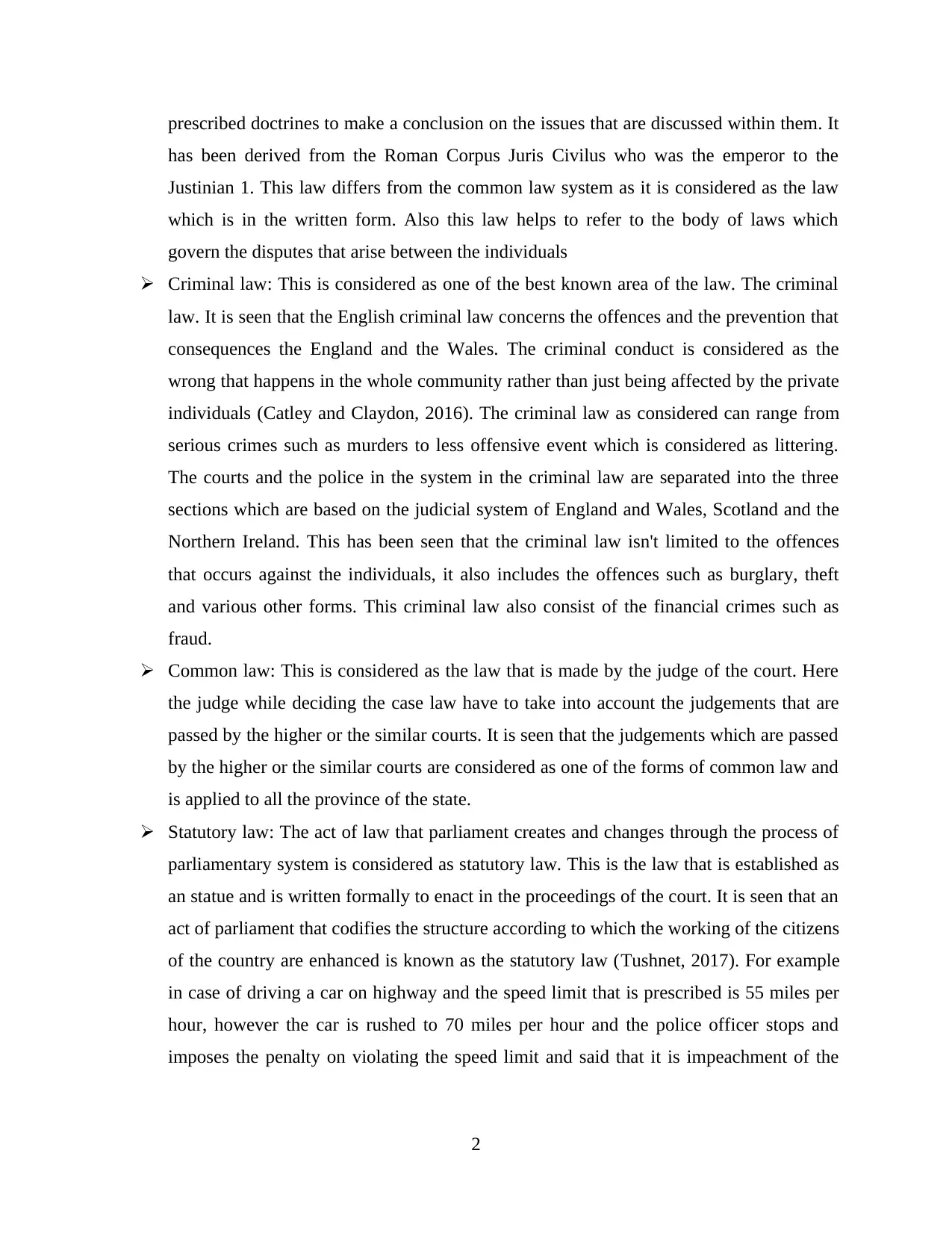
prescribed doctrines to make a conclusion on the issues that are discussed within them. It
has been derived from the Roman Corpus Juris Civilus who was the emperor to the
Justinian 1. This law differs from the common law system as it is considered as the law
which is in the written form. Also this law helps to refer to the body of laws which
govern the disputes that arise between the individuals
Criminal law: This is considered as one of the best known area of the law. The criminal
law. It is seen that the English criminal law concerns the offences and the prevention that
consequences the England and the Wales. The criminal conduct is considered as the
wrong that happens in the whole community rather than just being affected by the private
individuals (Catley and Claydon, 2016). The criminal law as considered can range from
serious crimes such as murders to less offensive event which is considered as littering.
The courts and the police in the system in the criminal law are separated into the three
sections which are based on the judicial system of England and Wales, Scotland and the
Northern Ireland. This has been seen that the criminal law isn't limited to the offences
that occurs against the individuals, it also includes the offences such as burglary, theft
and various other forms. This criminal law also consist of the financial crimes such as
fraud.
Common law: This is considered as the law that is made by the judge of the court. Here
the judge while deciding the case law have to take into account the judgements that are
passed by the higher or the similar courts. It is seen that the judgements which are passed
by the higher or the similar courts are considered as one of the forms of common law and
is applied to all the province of the state.
Statutory law: The act of law that parliament creates and changes through the process of
parliamentary system is considered as statutory law. This is the law that is established as
an statue and is written formally to enact in the proceedings of the court. It is seen that an
act of parliament that codifies the structure according to which the working of the citizens
of the country are enhanced is known as the statutory law (Tushnet, 2017). For example
in case of driving a car on highway and the speed limit that is prescribed is 55 miles per
hour, however the car is rushed to 70 miles per hour and the police officer stops and
imposes the penalty on violating the speed limit and said that it is impeachment of the
2
has been derived from the Roman Corpus Juris Civilus who was the emperor to the
Justinian 1. This law differs from the common law system as it is considered as the law
which is in the written form. Also this law helps to refer to the body of laws which
govern the disputes that arise between the individuals
Criminal law: This is considered as one of the best known area of the law. The criminal
law. It is seen that the English criminal law concerns the offences and the prevention that
consequences the England and the Wales. The criminal conduct is considered as the
wrong that happens in the whole community rather than just being affected by the private
individuals (Catley and Claydon, 2016). The criminal law as considered can range from
serious crimes such as murders to less offensive event which is considered as littering.
The courts and the police in the system in the criminal law are separated into the three
sections which are based on the judicial system of England and Wales, Scotland and the
Northern Ireland. This has been seen that the criminal law isn't limited to the offences
that occurs against the individuals, it also includes the offences such as burglary, theft
and various other forms. This criminal law also consist of the financial crimes such as
fraud.
Common law: This is considered as the law that is made by the judge of the court. Here
the judge while deciding the case law have to take into account the judgements that are
passed by the higher or the similar courts. It is seen that the judgements which are passed
by the higher or the similar courts are considered as one of the forms of common law and
is applied to all the province of the state.
Statutory law: The act of law that parliament creates and changes through the process of
parliamentary system is considered as statutory law. This is the law that is established as
an statue and is written formally to enact in the proceedings of the court. It is seen that an
act of parliament that codifies the structure according to which the working of the citizens
of the country are enhanced is known as the statutory law (Tushnet, 2017). For example
in case of driving a car on highway and the speed limit that is prescribed is 55 miles per
hour, however the car is rushed to 70 miles per hour and the police officer stops and
imposes the penalty on violating the speed limit and said that it is impeachment of the
2
Paraphrase This Document
Need a fresh take? Get an instant paraphrase of this document with our AI Paraphraser
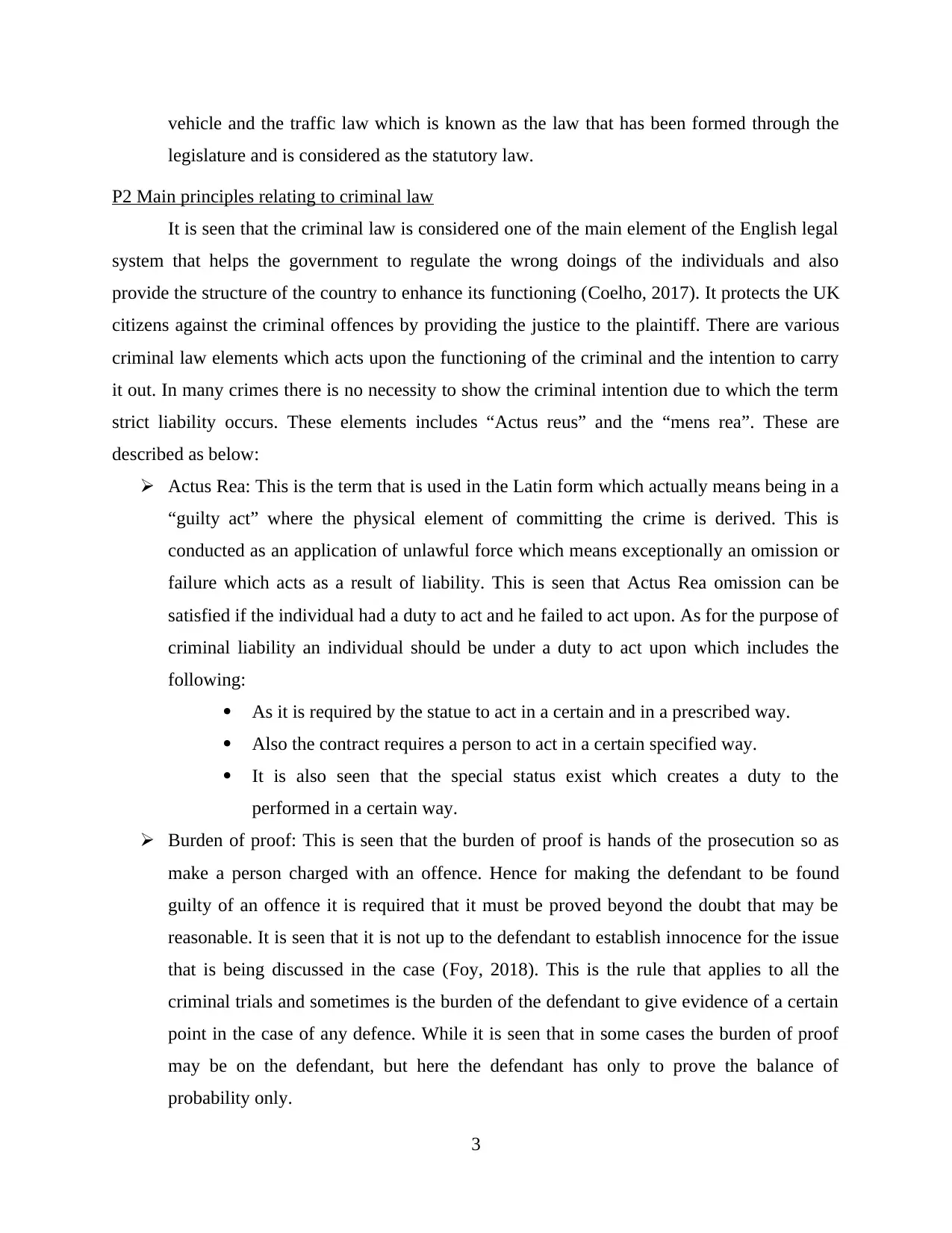
vehicle and the traffic law which is known as the law that has been formed through the
legislature and is considered as the statutory law.
P2 Main principles relating to criminal law
It is seen that the criminal law is considered one of the main element of the English legal
system that helps the government to regulate the wrong doings of the individuals and also
provide the structure of the country to enhance its functioning (Coelho, 2017). It protects the UK
citizens against the criminal offences by providing the justice to the plaintiff. There are various
criminal law elements which acts upon the functioning of the criminal and the intention to carry
it out. In many crimes there is no necessity to show the criminal intention due to which the term
strict liability occurs. These elements includes “Actus reus” and the “mens rea”. These are
described as below:
Actus Rea: This is the term that is used in the Latin form which actually means being in a
“guilty act” where the physical element of committing the crime is derived. This is
conducted as an application of unlawful force which means exceptionally an omission or
failure which acts as a result of liability. This is seen that Actus Rea omission can be
satisfied if the individual had a duty to act and he failed to act upon. As for the purpose of
criminal liability an individual should be under a duty to act upon which includes the
following:
As it is required by the statue to act in a certain and in a prescribed way.
Also the contract requires a person to act in a certain specified way.
It is also seen that the special status exist which creates a duty to the
performed in a certain way.
Burden of proof: This is seen that the burden of proof is hands of the prosecution so as
make a person charged with an offence. Hence for making the defendant to be found
guilty of an offence it is required that it must be proved beyond the doubt that may be
reasonable. It is seen that it is not up to the defendant to establish innocence for the issue
that is being discussed in the case (Foy, 2018). This is the rule that applies to all the
criminal trials and sometimes is the burden of the defendant to give evidence of a certain
point in the case of any defence. While it is seen that in some cases the burden of proof
may be on the defendant, but here the defendant has only to prove the balance of
probability only.
3
legislature and is considered as the statutory law.
P2 Main principles relating to criminal law
It is seen that the criminal law is considered one of the main element of the English legal
system that helps the government to regulate the wrong doings of the individuals and also
provide the structure of the country to enhance its functioning (Coelho, 2017). It protects the UK
citizens against the criminal offences by providing the justice to the plaintiff. There are various
criminal law elements which acts upon the functioning of the criminal and the intention to carry
it out. In many crimes there is no necessity to show the criminal intention due to which the term
strict liability occurs. These elements includes “Actus reus” and the “mens rea”. These are
described as below:
Actus Rea: This is the term that is used in the Latin form which actually means being in a
“guilty act” where the physical element of committing the crime is derived. This is
conducted as an application of unlawful force which means exceptionally an omission or
failure which acts as a result of liability. This is seen that Actus Rea omission can be
satisfied if the individual had a duty to act and he failed to act upon. As for the purpose of
criminal liability an individual should be under a duty to act upon which includes the
following:
As it is required by the statue to act in a certain and in a prescribed way.
Also the contract requires a person to act in a certain specified way.
It is also seen that the special status exist which creates a duty to the
performed in a certain way.
Burden of proof: This is seen that the burden of proof is hands of the prosecution so as
make a person charged with an offence. Hence for making the defendant to be found
guilty of an offence it is required that it must be proved beyond the doubt that may be
reasonable. It is seen that it is not up to the defendant to establish innocence for the issue
that is being discussed in the case (Foy, 2018). This is the rule that applies to all the
criminal trials and sometimes is the burden of the defendant to give evidence of a certain
point in the case of any defence. While it is seen that in some cases the burden of proof
may be on the defendant, but here the defendant has only to prove the balance of
probability only.
3
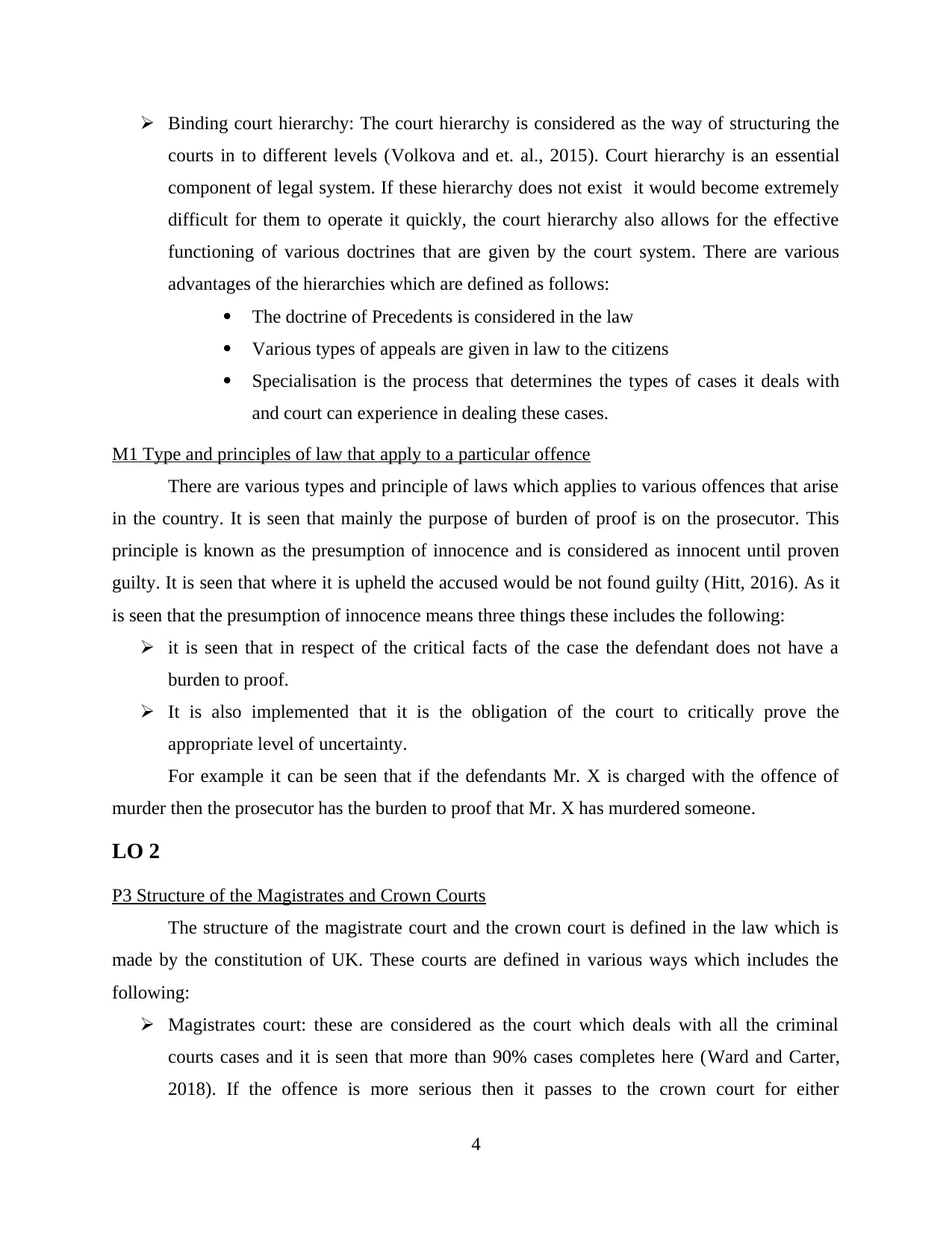
Binding court hierarchy: The court hierarchy is considered as the way of structuring the
courts in to different levels (Volkova and et. al., 2015). Court hierarchy is an essential
component of legal system. If these hierarchy does not exist it would become extremely
difficult for them to operate it quickly, the court hierarchy also allows for the effective
functioning of various doctrines that are given by the court system. There are various
advantages of the hierarchies which are defined as follows:
The doctrine of Precedents is considered in the law
Various types of appeals are given in law to the citizens
Specialisation is the process that determines the types of cases it deals with
and court can experience in dealing these cases.
M1 Type and principles of law that apply to a particular offence
There are various types and principle of laws which applies to various offences that arise
in the country. It is seen that mainly the purpose of burden of proof is on the prosecutor. This
principle is known as the presumption of innocence and is considered as innocent until proven
guilty. It is seen that where it is upheld the accused would be not found guilty (Hitt, 2016). As it
is seen that the presumption of innocence means three things these includes the following:
it is seen that in respect of the critical facts of the case the defendant does not have a
burden to proof.
It is also implemented that it is the obligation of the court to critically prove the
appropriate level of uncertainty.
For example it can be seen that if the defendants Mr. X is charged with the offence of
murder then the prosecutor has the burden to proof that Mr. X has murdered someone.
LO 2
P3 Structure of the Magistrates and Crown Courts
The structure of the magistrate court and the crown court is defined in the law which is
made by the constitution of UK. These courts are defined in various ways which includes the
following:
Magistrates court: these are considered as the court which deals with all the criminal
courts cases and it is seen that more than 90% cases completes here (Ward and Carter,
2018). If the offence is more serious then it passes to the crown court for either
4
courts in to different levels (Volkova and et. al., 2015). Court hierarchy is an essential
component of legal system. If these hierarchy does not exist it would become extremely
difficult for them to operate it quickly, the court hierarchy also allows for the effective
functioning of various doctrines that are given by the court system. There are various
advantages of the hierarchies which are defined as follows:
The doctrine of Precedents is considered in the law
Various types of appeals are given in law to the citizens
Specialisation is the process that determines the types of cases it deals with
and court can experience in dealing these cases.
M1 Type and principles of law that apply to a particular offence
There are various types and principle of laws which applies to various offences that arise
in the country. It is seen that mainly the purpose of burden of proof is on the prosecutor. This
principle is known as the presumption of innocence and is considered as innocent until proven
guilty. It is seen that where it is upheld the accused would be not found guilty (Hitt, 2016). As it
is seen that the presumption of innocence means three things these includes the following:
it is seen that in respect of the critical facts of the case the defendant does not have a
burden to proof.
It is also implemented that it is the obligation of the court to critically prove the
appropriate level of uncertainty.
For example it can be seen that if the defendants Mr. X is charged with the offence of
murder then the prosecutor has the burden to proof that Mr. X has murdered someone.
LO 2
P3 Structure of the Magistrates and Crown Courts
The structure of the magistrate court and the crown court is defined in the law which is
made by the constitution of UK. These courts are defined in various ways which includes the
following:
Magistrates court: these are considered as the court which deals with all the criminal
courts cases and it is seen that more than 90% cases completes here (Ward and Carter,
2018). If the offence is more serious then it passes to the crown court for either
4
⊘ This is a preview!⊘
Do you want full access?
Subscribe today to unlock all pages.

Trusted by 1+ million students worldwide
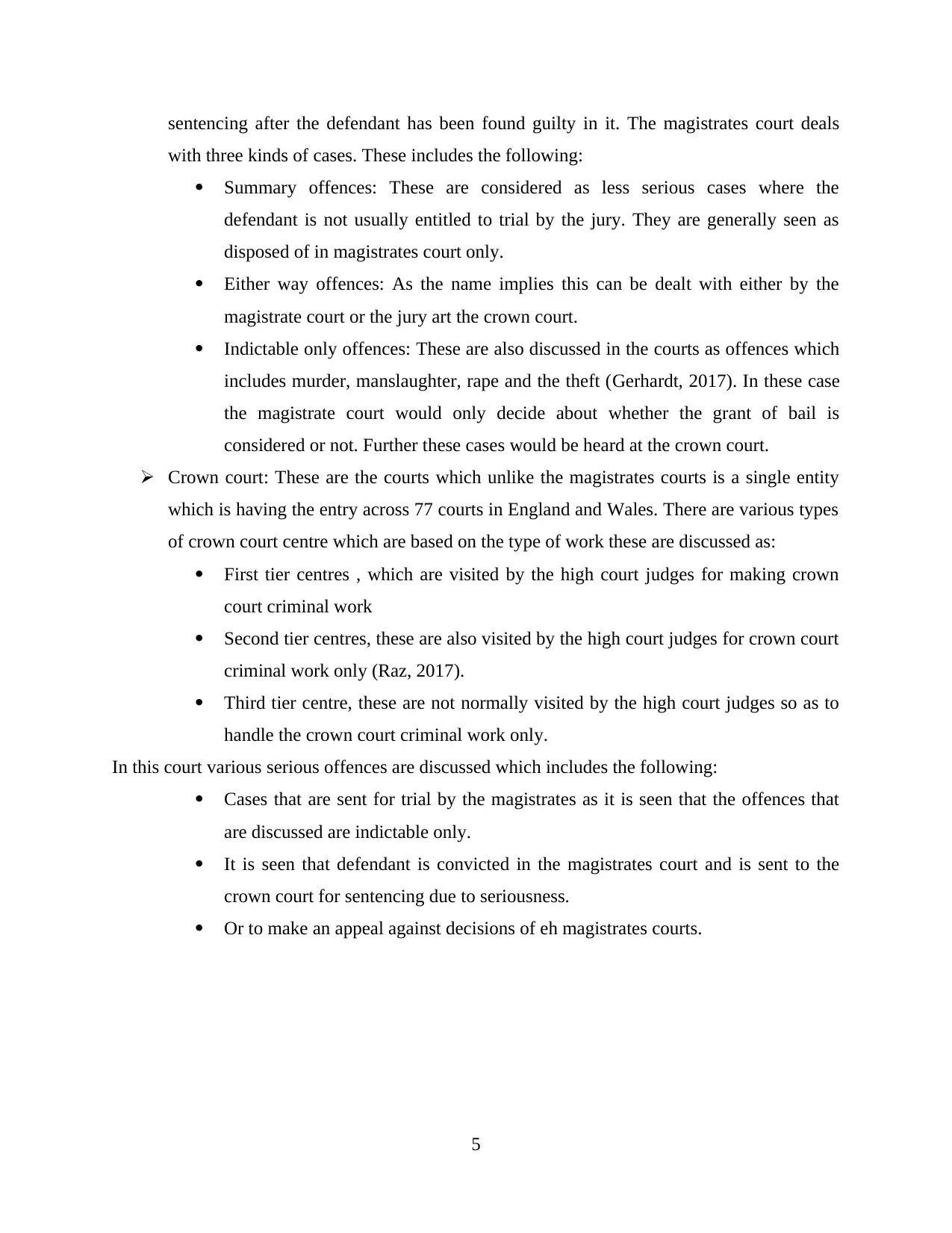
sentencing after the defendant has been found guilty in it. The magistrates court deals
with three kinds of cases. These includes the following:
Summary offences: These are considered as less serious cases where the
defendant is not usually entitled to trial by the jury. They are generally seen as
disposed of in magistrates court only.
Either way offences: As the name implies this can be dealt with either by the
magistrate court or the jury art the crown court.
Indictable only offences: These are also discussed in the courts as offences which
includes murder, manslaughter, rape and the theft (Gerhardt, 2017). In these case
the magistrate court would only decide about whether the grant of bail is
considered or not. Further these cases would be heard at the crown court.
Crown court: These are the courts which unlike the magistrates courts is a single entity
which is having the entry across 77 courts in England and Wales. There are various types
of crown court centre which are based on the type of work these are discussed as:
First tier centres , which are visited by the high court judges for making crown
court criminal work
Second tier centres, these are also visited by the high court judges for crown court
criminal work only (Raz, 2017).
Third tier centre, these are not normally visited by the high court judges so as to
handle the crown court criminal work only.
In this court various serious offences are discussed which includes the following:
Cases that are sent for trial by the magistrates as it is seen that the offences that
are discussed are indictable only.
It is seen that defendant is convicted in the magistrates court and is sent to the
crown court for sentencing due to seriousness.
Or to make an appeal against decisions of eh magistrates courts.
5
with three kinds of cases. These includes the following:
Summary offences: These are considered as less serious cases where the
defendant is not usually entitled to trial by the jury. They are generally seen as
disposed of in magistrates court only.
Either way offences: As the name implies this can be dealt with either by the
magistrate court or the jury art the crown court.
Indictable only offences: These are also discussed in the courts as offences which
includes murder, manslaughter, rape and the theft (Gerhardt, 2017). In these case
the magistrate court would only decide about whether the grant of bail is
considered or not. Further these cases would be heard at the crown court.
Crown court: These are the courts which unlike the magistrates courts is a single entity
which is having the entry across 77 courts in England and Wales. There are various types
of crown court centre which are based on the type of work these are discussed as:
First tier centres , which are visited by the high court judges for making crown
court criminal work
Second tier centres, these are also visited by the high court judges for crown court
criminal work only (Raz, 2017).
Third tier centre, these are not normally visited by the high court judges so as to
handle the crown court criminal work only.
In this court various serious offences are discussed which includes the following:
Cases that are sent for trial by the magistrates as it is seen that the offences that
are discussed are indictable only.
It is seen that defendant is convicted in the magistrates court and is sent to the
crown court for sentencing due to seriousness.
Or to make an appeal against decisions of eh magistrates courts.
5
Paraphrase This Document
Need a fresh take? Get an instant paraphrase of this document with our AI Paraphraser
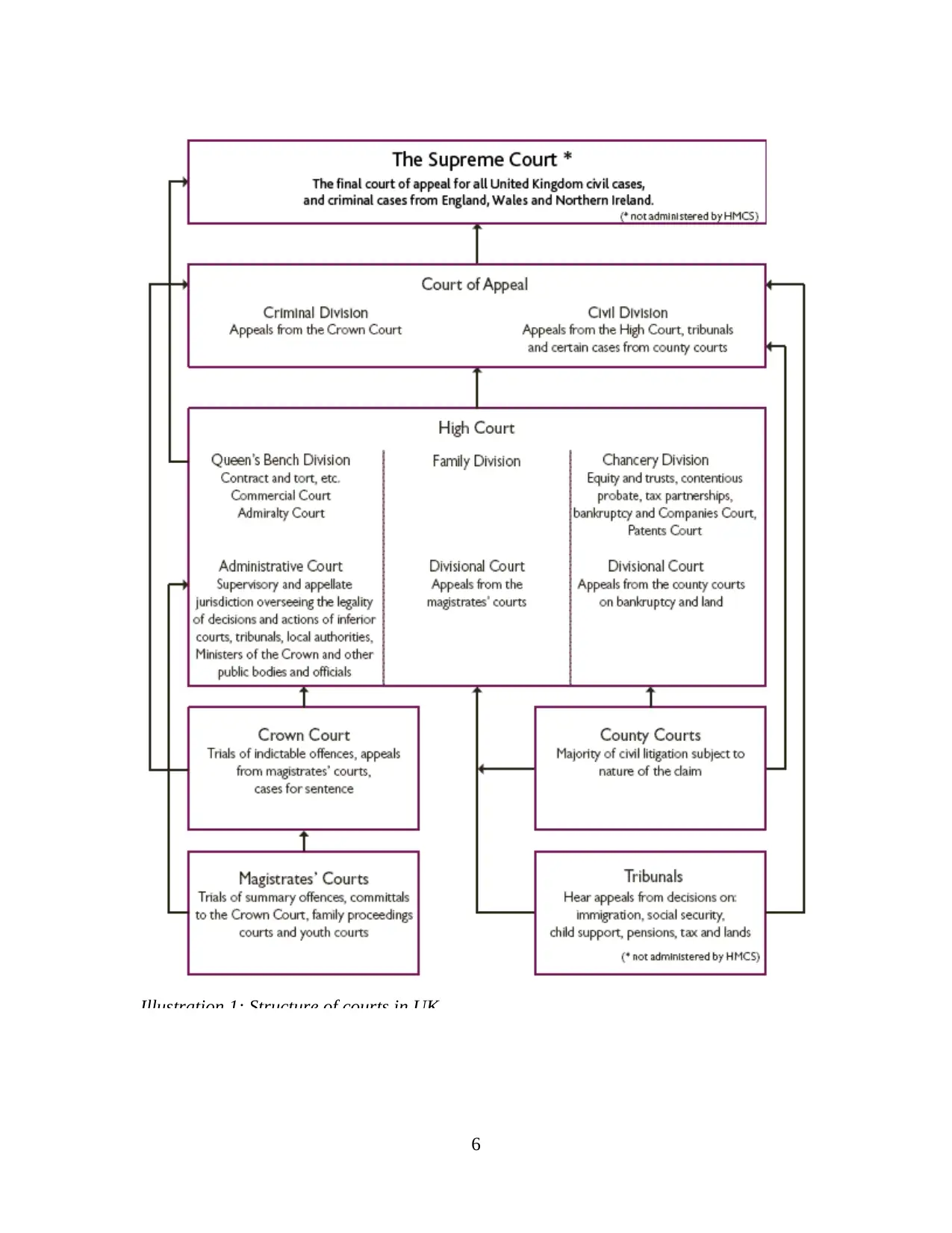
6
Illustration 1: Structure of courts in UK
Illustration 1: Structure of courts in UK
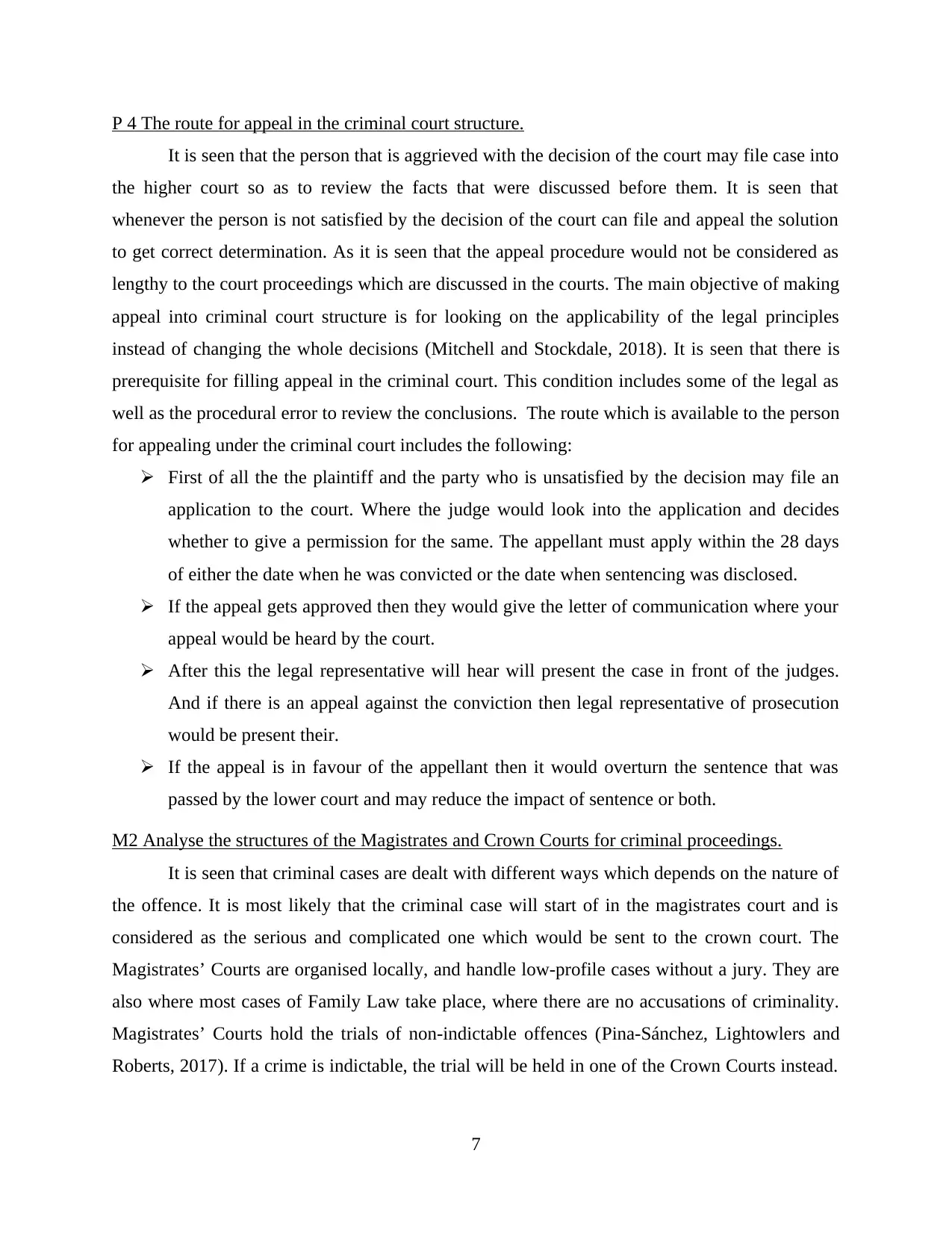
P 4 The route for appeal in the criminal court structure.
It is seen that the person that is aggrieved with the decision of the court may file case into
the higher court so as to review the facts that were discussed before them. It is seen that
whenever the person is not satisfied by the decision of the court can file and appeal the solution
to get correct determination. As it is seen that the appeal procedure would not be considered as
lengthy to the court proceedings which are discussed in the courts. The main objective of making
appeal into criminal court structure is for looking on the applicability of the legal principles
instead of changing the whole decisions (Mitchell and Stockdale, 2018). It is seen that there is
prerequisite for filling appeal in the criminal court. This condition includes some of the legal as
well as the procedural error to review the conclusions. The route which is available to the person
for appealing under the criminal court includes the following:
First of all the the plaintiff and the party who is unsatisfied by the decision may file an
application to the court. Where the judge would look into the application and decides
whether to give a permission for the same. The appellant must apply within the 28 days
of either the date when he was convicted or the date when sentencing was disclosed.
If the appeal gets approved then they would give the letter of communication where your
appeal would be heard by the court.
After this the legal representative will hear will present the case in front of the judges.
And if there is an appeal against the conviction then legal representative of prosecution
would be present their.
If the appeal is in favour of the appellant then it would overturn the sentence that was
passed by the lower court and may reduce the impact of sentence or both.
M2 Analyse the structures of the Magistrates and Crown Courts for criminal proceedings.
It is seen that criminal cases are dealt with different ways which depends on the nature of
the offence. It is most likely that the criminal case will start of in the magistrates court and is
considered as the serious and complicated one which would be sent to the crown court. The
Magistrates’ Courts are organised locally, and handle low-profile cases without a jury. They are
also where most cases of Family Law take place, where there are no accusations of criminality.
Magistrates’ Courts hold the trials of non-indictable offences (Pina-Sánchez, Lightowlers and
Roberts, 2017). If a crime is indictable, the trial will be held in one of the Crown Courts instead.
7
It is seen that the person that is aggrieved with the decision of the court may file case into
the higher court so as to review the facts that were discussed before them. It is seen that
whenever the person is not satisfied by the decision of the court can file and appeal the solution
to get correct determination. As it is seen that the appeal procedure would not be considered as
lengthy to the court proceedings which are discussed in the courts. The main objective of making
appeal into criminal court structure is for looking on the applicability of the legal principles
instead of changing the whole decisions (Mitchell and Stockdale, 2018). It is seen that there is
prerequisite for filling appeal in the criminal court. This condition includes some of the legal as
well as the procedural error to review the conclusions. The route which is available to the person
for appealing under the criminal court includes the following:
First of all the the plaintiff and the party who is unsatisfied by the decision may file an
application to the court. Where the judge would look into the application and decides
whether to give a permission for the same. The appellant must apply within the 28 days
of either the date when he was convicted or the date when sentencing was disclosed.
If the appeal gets approved then they would give the letter of communication where your
appeal would be heard by the court.
After this the legal representative will hear will present the case in front of the judges.
And if there is an appeal against the conviction then legal representative of prosecution
would be present their.
If the appeal is in favour of the appellant then it would overturn the sentence that was
passed by the lower court and may reduce the impact of sentence or both.
M2 Analyse the structures of the Magistrates and Crown Courts for criminal proceedings.
It is seen that criminal cases are dealt with different ways which depends on the nature of
the offence. It is most likely that the criminal case will start of in the magistrates court and is
considered as the serious and complicated one which would be sent to the crown court. The
Magistrates’ Courts are organised locally, and handle low-profile cases without a jury. They are
also where most cases of Family Law take place, where there are no accusations of criminality.
Magistrates’ Courts hold the trials of non-indictable offences (Pina-Sánchez, Lightowlers and
Roberts, 2017). If a crime is indictable, the trial will be held in one of the Crown Courts instead.
7
⊘ This is a preview!⊘
Do you want full access?
Subscribe today to unlock all pages.

Trusted by 1+ million students worldwide
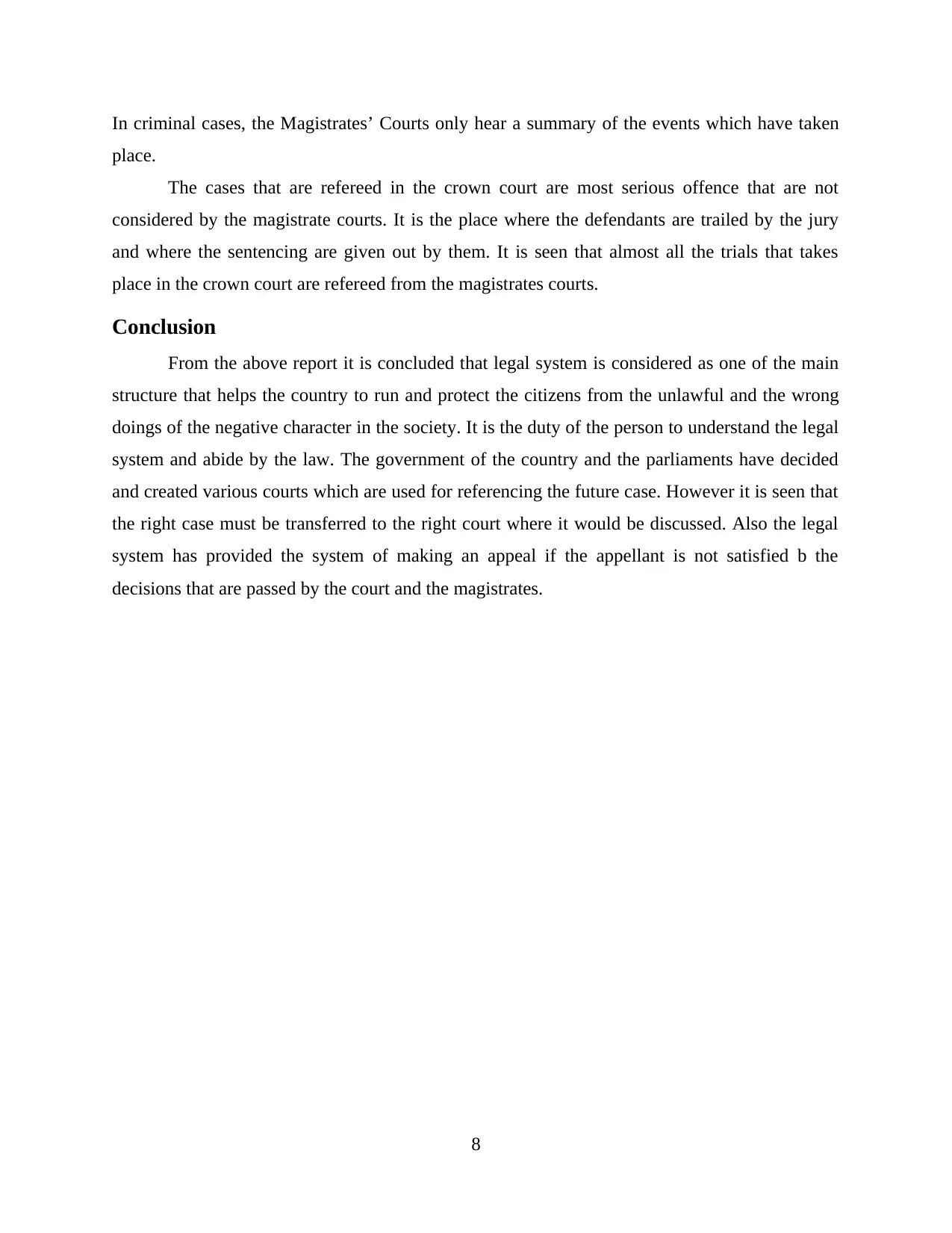
In criminal cases, the Magistrates’ Courts only hear a summary of the events which have taken
place.
The cases that are refereed in the crown court are most serious offence that are not
considered by the magistrate courts. It is the place where the defendants are trailed by the jury
and where the sentencing are given out by them. It is seen that almost all the trials that takes
place in the crown court are refereed from the magistrates courts.
Conclusion
From the above report it is concluded that legal system is considered as one of the main
structure that helps the country to run and protect the citizens from the unlawful and the wrong
doings of the negative character in the society. It is the duty of the person to understand the legal
system and abide by the law. The government of the country and the parliaments have decided
and created various courts which are used for referencing the future case. However it is seen that
the right case must be transferred to the right court where it would be discussed. Also the legal
system has provided the system of making an appeal if the appellant is not satisfied b the
decisions that are passed by the court and the magistrates.
8
place.
The cases that are refereed in the crown court are most serious offence that are not
considered by the magistrate courts. It is the place where the defendants are trailed by the jury
and where the sentencing are given out by them. It is seen that almost all the trials that takes
place in the crown court are refereed from the magistrates courts.
Conclusion
From the above report it is concluded that legal system is considered as one of the main
structure that helps the country to run and protect the citizens from the unlawful and the wrong
doings of the negative character in the society. It is the duty of the person to understand the legal
system and abide by the law. The government of the country and the parliaments have decided
and created various courts which are used for referencing the future case. However it is seen that
the right case must be transferred to the right court where it would be discussed. Also the legal
system has provided the system of making an appeal if the appellant is not satisfied b the
decisions that are passed by the court and the magistrates.
8
Paraphrase This Document
Need a fresh take? Get an instant paraphrase of this document with our AI Paraphraser
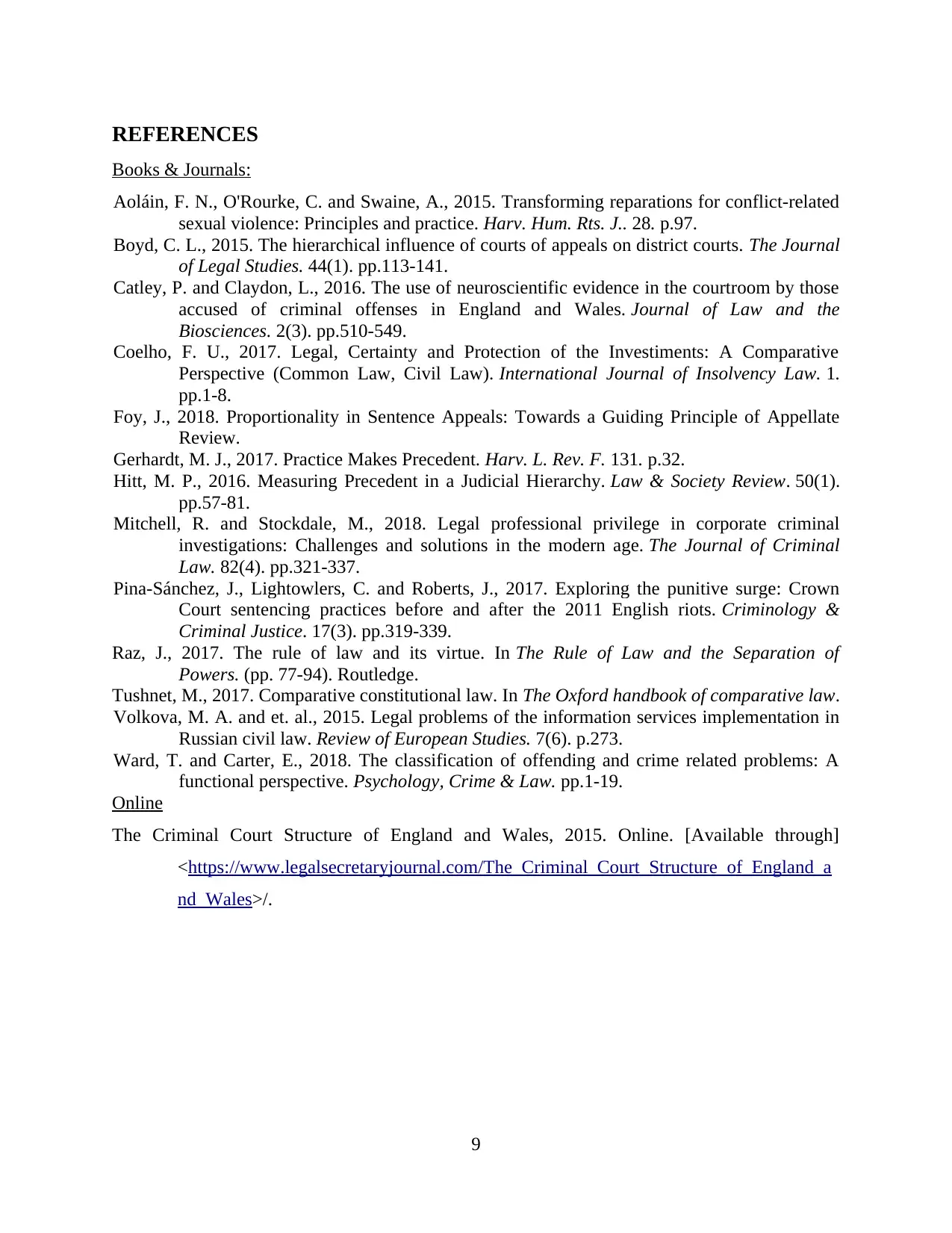
REFERENCES
Books & Journals:
Aoláin, F. N., O'Rourke, C. and Swaine, A., 2015. Transforming reparations for conflict-related
sexual violence: Principles and practice. Harv. Hum. Rts. J.. 28. p.97.
Boyd, C. L., 2015. The hierarchical influence of courts of appeals on district courts. The Journal
of Legal Studies. 44(1). pp.113-141.
Catley, P. and Claydon, L., 2016. The use of neuroscientific evidence in the courtroom by those
accused of criminal offenses in England and Wales. Journal of Law and the
Biosciences. 2(3). pp.510-549.
Coelho, F. U., 2017. Legal, Certainty and Protection of the Investiments: A Comparative
Perspective (Common Law, Civil Law). International Journal of Insolvency Law. 1.
pp.1-8.
Foy, J., 2018. Proportionality in Sentence Appeals: Towards a Guiding Principle of Appellate
Review.
Gerhardt, M. J., 2017. Practice Makes Precedent. Harv. L. Rev. F. 131. p.32.
Hitt, M. P., 2016. Measuring Precedent in a Judicial Hierarchy. Law & Society Review. 50(1).
pp.57-81.
Mitchell, R. and Stockdale, M., 2018. Legal professional privilege in corporate criminal
investigations: Challenges and solutions in the modern age. The Journal of Criminal
Law. 82(4). pp.321-337.
Pina-Sánchez, J., Lightowlers, C. and Roberts, J., 2017. Exploring the punitive surge: Crown
Court sentencing practices before and after the 2011 English riots. Criminology &
Criminal Justice. 17(3). pp.319-339.
Raz, J., 2017. The rule of law and its virtue. In The Rule of Law and the Separation of
Powers. (pp. 77-94). Routledge.
Tushnet, M., 2017. Comparative constitutional law. In The Oxford handbook of comparative law.
Volkova, M. A. and et. al., 2015. Legal problems of the information services implementation in
Russian civil law. Review of European Studies. 7(6). p.273.
Ward, T. and Carter, E., 2018. The classification of offending and crime related problems: A
functional perspective. Psychology, Crime & Law. pp.1-19.
Online
The Criminal Court Structure of England and Wales, 2015. Online. [Available through]
<https://www.legalsecretaryjournal.com/The_Criminal_Court_Structure_of_England_a
nd_Wales>/.
9
Books & Journals:
Aoláin, F. N., O'Rourke, C. and Swaine, A., 2015. Transforming reparations for conflict-related
sexual violence: Principles and practice. Harv. Hum. Rts. J.. 28. p.97.
Boyd, C. L., 2015. The hierarchical influence of courts of appeals on district courts. The Journal
of Legal Studies. 44(1). pp.113-141.
Catley, P. and Claydon, L., 2016. The use of neuroscientific evidence in the courtroom by those
accused of criminal offenses in England and Wales. Journal of Law and the
Biosciences. 2(3). pp.510-549.
Coelho, F. U., 2017. Legal, Certainty and Protection of the Investiments: A Comparative
Perspective (Common Law, Civil Law). International Journal of Insolvency Law. 1.
pp.1-8.
Foy, J., 2018. Proportionality in Sentence Appeals: Towards a Guiding Principle of Appellate
Review.
Gerhardt, M. J., 2017. Practice Makes Precedent. Harv. L. Rev. F. 131. p.32.
Hitt, M. P., 2016. Measuring Precedent in a Judicial Hierarchy. Law & Society Review. 50(1).
pp.57-81.
Mitchell, R. and Stockdale, M., 2018. Legal professional privilege in corporate criminal
investigations: Challenges and solutions in the modern age. The Journal of Criminal
Law. 82(4). pp.321-337.
Pina-Sánchez, J., Lightowlers, C. and Roberts, J., 2017. Exploring the punitive surge: Crown
Court sentencing practices before and after the 2011 English riots. Criminology &
Criminal Justice. 17(3). pp.319-339.
Raz, J., 2017. The rule of law and its virtue. In The Rule of Law and the Separation of
Powers. (pp. 77-94). Routledge.
Tushnet, M., 2017. Comparative constitutional law. In The Oxford handbook of comparative law.
Volkova, M. A. and et. al., 2015. Legal problems of the information services implementation in
Russian civil law. Review of European Studies. 7(6). p.273.
Ward, T. and Carter, E., 2018. The classification of offending and crime related problems: A
functional perspective. Psychology, Crime & Law. pp.1-19.
Online
The Criminal Court Structure of England and Wales, 2015. Online. [Available through]
<https://www.legalsecretaryjournal.com/The_Criminal_Court_Structure_of_England_a
nd_Wales>/.
9
1 out of 11
Related Documents
Your All-in-One AI-Powered Toolkit for Academic Success.
+13062052269
info@desklib.com
Available 24*7 on WhatsApp / Email
![[object Object]](/_next/static/media/star-bottom.7253800d.svg)
Unlock your academic potential
Copyright © 2020–2025 A2Z Services. All Rights Reserved. Developed and managed by ZUCOL.




